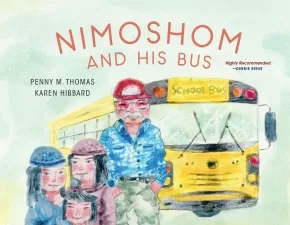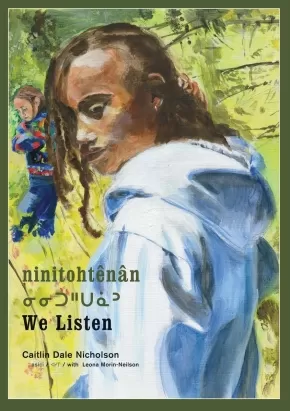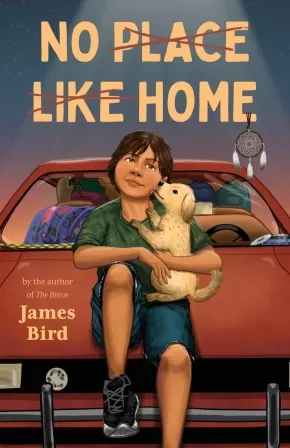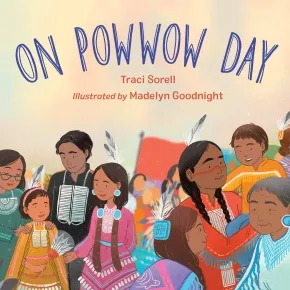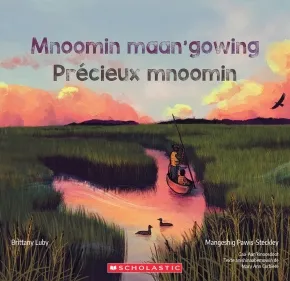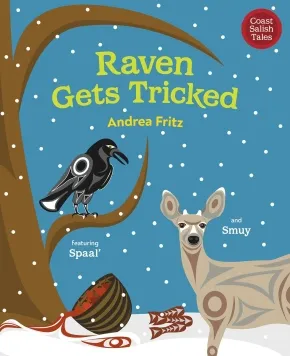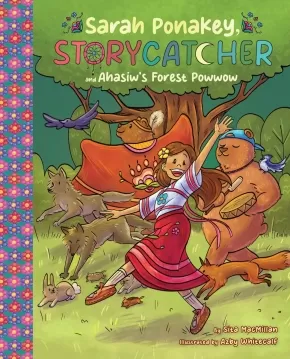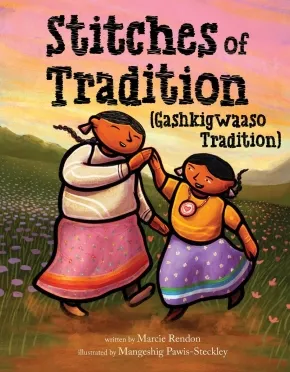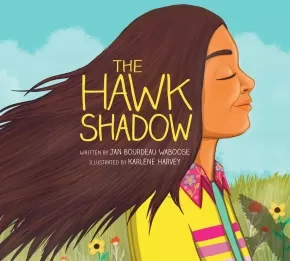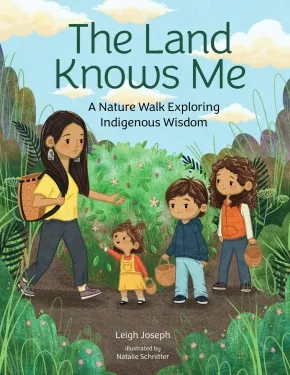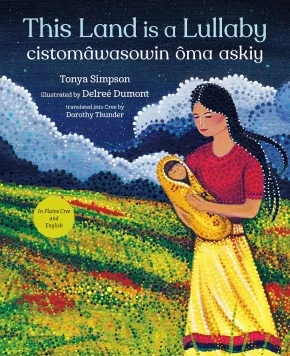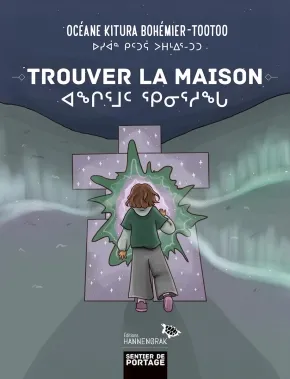
Language
106
-
120
of
422 Results;
Sort By
Go To
of 29
Nimoshom and His Bus (PB)
$14.00
Artists:
Format:
Paperback
Text Content Territories:
Indigenous Canadian; First Nations; Cree (Nehiyawak);
Grade Levels: Preschool; Kindergarten;
ISBN / Barcode: 9781774921166
Synopsis:
Synopsis:
In this warm and joyful picture book highly recommended by Debbie Reese, children learn Cree from Nimoshom, their school bus driver.
Based on the author’s memories of her grandfather, Nimoshom is not your average bus driver. He loves to drive the school bus, tell silly stories, and share his language with the kids who ride his bus.
Nimoshom and His Bus introduces readers to common Cree words and phrases alongside the common childhood experience of riding the school bus. A Cree word list is included in the back of the book.
Reviews
"Through accessible language and engaging visual resources, readers are introduced to basic Cree as Nimoshom responds in this language to the children who ride his bus.... The illustrator’s varying the visuals between full double spreads and single page illustrations keeps the pacing lively. Amidst a rural fall setting, with woodland animals, children, and the school bus, Nimoshom’s humorous nature shines through these gentle illustrations. At the end of this story, you just want to give Nimoshom a great big hug!"— Anita Miettunen, CM: Canadian Review of Materials
"In this bilingual book, readers follow a bus driver picking up kids and dropping them off before and after school. Like the students on the bus, readers quickly learn that the driver's native language is Cree, and he often speaks to them in his native language. Readers learn that "Nimoshom" means "my grandfather" and that "Ekosani" means thank you" as the author (of Cree descent herself) weaves Cree words into the text, and each new spread almost feels like a gentle wave: yes, we're subtly learning new words, but it never feels strenuous or forced, rather it's calm and poetic."— Let's Talk Picture Books
"While Penny M. Thomas' story is not a plot-driven allegory or a message-based lesson, Nimoshom and His Bus is a sweet introduction to some simple Cree words in the context of a common-place activity for many children.... Karen Hibbard who uses watercolours and pastels to create a gentle background for Nimoshom's day on his bus gives the story a grassroots mood, highly appropriate for a routine day of activity and interaction for this bus driver and his charges. It's very relatable."— Helen Kubiw, CanLit for Little Canadians
"If you're a regular reader of AICL, you know that we're always delighted by books by Native writers--especially ones set in the present. Books like Nimoshom and His Bus provide Native children with mirrors that non-Native children find in abundance.... I highly recommend Nimoshom and His Bus! It'd be a simple thing to use other Native words in addition to--or instead of--the Cree words in the book."— Debbie Reese, American Indians in Children's Literature
Educator Information
Recommended for ages 3 to 5.
Additional Information
24 pages | 9.50" x 7.50" | Paperback
ninitohtênân / We Listen
$21.99
Artists:
Format:
Hardcover
Text Content Territories:
Indigenous Canadian; First Nations; Cree (Nehiyawak);
ISBN / Barcode: 9781773068596
Synopsis:
Synopsis:
The third book in the Nôhkom series, in Cree and English, tells a story about gathering leaves for Labrador tea, while listening in different ways.
A child, her family and her friend have arrived at their favorite picnic spot by the lake, but before they eat lunch Nôhkom suggests they pick leaves for Labrador tea. Once among the trees, Nôhkom pauses for a moment to listen, and the others do too. Nôhkom prays, the girls take their turn, then Nôhkom shows them where to find the leaves. Nôhkom and Mom rest after harvesting, but the girls opt for a swim in the lake ... though they're quite happy to warm up afterwards with freshly brewed Labrador tea. And when it's time for the picnic, the girls take another turn at listening.
Beautifully rendered paintings in acrylic on canvas show the family outing. Includes a recipe for Labrador tea as well as a salve made from Labrador Tea leaves.
Educator Information
Recommended Ages: 3 to 7.
Written in short sentences in Cree and English (with Cree text appearing in standard roman orthography and syllabics), the book is a good choice for beginning readers and/or language learners.
This book is the third book in the Nôhkom series.
The story features different forms of listening — in the bush, to teachings from Nôhkom, to the conversation of family and friends (when listening can be especially fun!).
Key Text Features
illustrations
recipe
informational note
Correlates to the Common Core State Standards in English Language Arts:
CCSS.ELA-LITERACY.RL.1.2
Retell stories, including key details, and demonstrate understanding of their central message or lesson.
CCSS.ELA-LITERACY.RL.1.7
Use illustrations and details in a story to describe its characters, setting, or events.
Authenticity Note: Translator Leona Morin-Neilson is the inspiration for the stories and art in the Nôhkom series, which highlights her traditional knowledge of the uses of wild plants. She collaborated with the author to create this work and translated it into Cree.
Because of the collaboration between Leona and the author, and Leona's Cree translation, this book has been labelled as containing Authentic Indigenous Text. It is up to readers to determine if this work is authentic for their purposes.
Additional Information
24 pages | 8.50" x 12.25" | Hardcover
No Place Like Home (PB)
$11.99
Format:
Paperback
Text Content Territories:
Indigenous American; Native American; Anishinaabeg; Ojibwe (Chippewa);
ISBN / Barcode: 9781250877611
Synopsis:
Synopsis:
A middle-grade novel by James Bird about homelessness and hope.
When home is a car, life is unpredictable. School, friends, and three meals a day aren't guaranteed. Not every town has a shelter where a family can sleep for a night or two, and places with parking lots don't welcome overnight stays.
Opin, his brother Emjay, and their mother are trying to get to Los Angeles, where they hope an uncle and a new life are waiting. Emjay has taken to disappearing for days, slowing down the family's progress and adding to their worry.
Then Opin finds a stray dog who needs him as much as he needs her, and his longing for a stable home intensifies, as his brother's reckless ways hit a new high. Opin makes a new friend in the shelter, but shelters don’t allow dogs…
Will anything other than a real home ever be enough?
Reviews
"Author Bird crafts this deeply felt ode to familial love with authoritative prose.... Opin's palpable fears, joys, and unrelenting hope buoy this tale of resilience." -- Publishers Weekly, starred review
"James Bird, who has been homeless and is of Ojibwe descent, writes with rare authority, insight, and compassion that invites deep empathy from readers. He has done a beautiful job of creating an unforgettable family, who, as Inde says, “may be broke, but we’re not broken.” -- Booklist, starred review
"Bird seamlessly weaves in historical events, like the government’s distribution of smallpox-infested blankets to kill Native people, while telling a story of admirable resilience. A thought-provoking story of one boy playing his own game of life. (song list, Ojibwe glossary, author’s note)." - Kirkus Reviews
Educator Information
Recommended for ages 10 to 14.
Subjects / Themes: Poverty, Homelessness, Pets, Pet Adoption, Ojibwe.
Includes some Ojibwe words and a glossary.
Additional Information
320 pages | 5.13" x 7.62" | Paperback
On Powwow Day (BB)
$10.99
Artists:
Format:
Board Book
Text Content Territories:
Indigenous American; Native American; Cherokee; Cherokee Nation (Cherokee Nation of Oklahoma);
Grade Levels: Preschool;
ISBN / Barcode: 9781623545765
Synopsis:
Synopsis:
In this board book by best-selling Native author Traci Sorell, discover colors, sounds, and counting from one to ten on powwow day!
This eye-catching, interactive board book is sure to keep toddlers engaged. Count one through ten as you make your way through the day of the powwow, looking for colors, family members, jingle dresses, musical instruments, and tribal citizens in this introduction to a traditional Native event.
An award-winning children's picture book adapted to be ready for little listeners in a warm and vibrant board book edition.
Reviews
"A colorful counting book engages children to identify the different visual elements that occur on powwow day. From the car that vrooms to the shaking shiny jingle cones, the exciting expressions catch more beyond the eye. The rainbow palette is shown off in organic and youthful design work. Every number from one to ten has a corresponding color, attached to a powwow day element. Readers can identify and count these elements, from the gray feathers on regalia to the bright moccasins. VERDICT This delightful picture book allows Indigenous children to connect with and feel pride in the abundance of powwow participation, and gives all readers a great counting book full of cultural imagery."—School Library Journal, starred review
Educator Information
Recommended for ages 3 and under.
Additional Information
20 pages | 5.88" x 5.88" | Board Book
Précieux mnoomin
$14.99
Format:
Paperback
Text Content Territories:
Indigenous Canadian; First Nations; Anishinaabeg; Ojibway;
ISBN / Barcode: 9781039705241
Synopsis:
Synopsis:
Un enfant anishinaabe explore l’histoire d’une precieuse graine de mnoomin et le cercle de vie que le mnoomin entretient.
Redigee en anishinaabemowin et en francais, l’histoire se deroule au moment de la recolte. L’enfant tient une graine de mnoomin et imagine toute la vie qui a rendu possible une seule graine : l’ephemere, le brochet, le rat musque, l’aigle et l’orignal ont tous eu un role a jouer dans sa creation. Que se passera-t-il si la graine germe? Les feuilles immergees abriteront les jeunes poissons, les pousses protegeront les canetons, les tiges nourriront les larves, qui a leur tour fourniront de la nourriture aux chauves-souris... jusqu’a ce que le mnoomin soit a nouveau pret a etre recolte.
Cette histoire magnifiquement ecrite et illustree revele l’importance culturelle et ecologique du mnoomin.
Educator Information
Recommedned for ages 4 to 6.
Written in Anishinaabemowin and French.
This book is available in Anishinaabemowin and English: Mnoomin maan'gowing / The Gift of Mnoomin.
Additional Information
36 pages | 8.51" x 8.73" | Paperback
Raven Gets Tricked
$21.95
Artists:
Format:
Hardcover
Text Content Territories:
Indigenous Canadian; First Nations; Salish; Coast Salish; Lyackson ;
ISBN / Barcode: 9781459836273
Synopsis:
Synopsis:
Sharing is the heart of friendship.
Indigenous artist and storyteller Andrea Fritz tells a tale of a greedy raven and the little deer who makes sure they both have enough food for the winter.
Smuy the little deer is almost out of food and wishes Spaal' the raven would share with him. But even though Smuy always offers to share with Spaal', Spaal' only ever tricks Smuy in return. So Smuy decides to try something new. He mashes the last of his stored berries and mixes them into the snow outside. Spaal' notices the delicious-looking red snow and asks to taste some. Smuy agrees, but this time he is prepared for Spaal's tricks and is ready with a little trick of his own—one that will ensure that both animals are warm and fed for the winter.
In this Traditional Story set in Coast Salish Traditional Territory, author and artist Andrea Fritz uses Indigenous storytelling techniques and art to share the culture and language of the Hul’q’umi’num’-speaking Peoples. This is the third book in the Coast Salish Tales, following Otter Doesn't Know and Crow Helps a Friend.
Educator & Series Information
Recommended for ages 6 to 8.
This is the third book in the Coast Salish Tales series, following Otter Doesn't Know and Crow Helps a Friend.
Fountas & Pinnell Text Level Gradient: N
Lexile measure: 530L
Guided Reading Level: N
Additional Information
32 pages | 8.75" x 10.75" | Hardcover
Sanirajak, A Place I Love
$16.95
Artists:
Format:
Paperback
Text Content Territories:
Indigenous Canadian; Inuit;
ISBN / Barcode: 9781774507704
Synopsis:
Synopsis:
Alice loves her community, and she's excited to show others her favourite things to see and do throughout the year. From ice fishing to collecting clams to cheering on hunters in the community, there is always something to enjoy in Sanirajak.
Educator & Series Information
Recommended for ages 5 to 7.
Dual-Language: English and Inuktitut
Readers will learn about different activities people do in each season in Sanirajak, Nunavut in Sanirajak, a Place I Love.
Sanirajak, a Place I Love teaches about the values of community and sharing food with community members after a hunt.
This book is part of the Community Connections series.
Additional Information
36 pages | 9.00" x 10.00" | Paperback
Sarah Ponakey, Storycatcher and Âhâsiw's Forest Powwow
$10.99
Artists:
Format:
Paperback
Text Content Territories:
Indigenous Canadian; First Nations; Cree (Nehiyawak);
ISBN / Barcode: 9781773218892
Synopsis:
Synopsis:
A vibrant debut early chapter book series celebrating Cree culture and being true to yourself.
Sarah Ponakey has moved to the city from her home community with her mom and it’s the pits! She misses her Kôhkom, her best friend Eden, and the forests around her community. She’s had a hard time making new friends at school but at least she keeps in touch with Eden through meticulously written letters with very big words. After a particularly tough day where she nearly loses her favorite stuffed animal, Âhâsiw, and is brushed off by her mom, Sarah finds herself transported to a magical forest powwow . . .
Accompanied by a life-sized Âhâsiw in his beautiful regalia, Sarah watches in excitement as a chipmunk emcees, and bears play the host drum at her first ever powwow. The more she sees, the more her confidence grows. As she joins in the celebration, Sarah discovers that she can connect to her Cree culture no matter where she is. Her Kôhkom’s going to love this story! Âhâsiw’s Forest Powwow, the first book from debut children’s author Sita MacMillan, features Cree words throughout the story and a note to the reader. Azby Whitecalf’s dynamic illustrations bring life to this warm, charming, and funny introduction to Sarah Ponakey, the storycatcher.
Educator & Series Information
Recommended for ages 6 to 9.
This is the first book in the Sarah Ponakey, Storycatcher series, a vibrant debut early chapter book series celebrating Cree culture and being true to yourself.
Additional Information
120 pages | 6.00" x 9.00" | Paperback
Stitches of Tradition (Gashkigwaaso Tradition)
$24.99
Format:
Hardcover
ISBN / Barcode: 9780063218680
Synopsis:
Synopsis:
“Noozhishenh, bimadiziwin,” Nookomis says. “My granddaughter, live a good life.”
An Ojibwe grandmother carefully measures and selects just the right colors of fabric, and her sewing machine hums whirr, whirr, whirr late into the night.
In the morning, her growing granddaughter has a beautiful new ribbon skirt to wear, a reminder of her nookomis and the cultural traditions that stitch together her family with love.
This heartwarming story by Marcie Rendon (Ojibwe), with stunning illustrations by Joshua Mangeshig Pawis-Steckley (Ojibwe), celebrates the power of Indigenous craft and community and weaves together the spirit of resilience, female empowerment, and gratitude for the generations that came before us.
Reviews
A radiant and joyful glimpse at an important Native tradition." — Kirkus Reviews (starred review)
"Tradition and love are the core of this picture book...Ojibwe language is seamlessly woven into the dialogue. The digital art fully saturates the pages, layering textures and colors much like the ribbon skirts, and the palette is buoyant and bright, exuding a celebratory feel." — Bulletin of the Center for Children’s Book"s
Educator Information
Recommended for ages 4 to 8.
Detailed text perfect for read-alouds.
Backmatter includes a glossary of Ojibwa terms, more information on ribbon skirts, including history and significance, and infromation about manoomin (wild rice).
Additional Information
40 pages | 8.50" x 11.00" | Hardcover
The Cherokee Syllabary: An Illustrated Key to the Cherokee Language
$21.95
Artists:
Format:
Hardcover
Text Content Territories:
Indigenous American; Native American; Cherokee;
ISBN / Barcode: 9781570674228
Synopsis:
Synopsis:
The Cherokee Syllabary: An Illustrated Key to the Cherokee Language reintroduces adults as well as children to their language once again. The introduction and pronunciation key aid in understanding the beautifully illustrated syllabary characters. Accompanying each illustration is a Cherokee word that contains the Cherokee syllabary character, the Cherokee sounds of each syllabary character in the word, the word in English and a row of syllabary characters with sound of each below. Young children will be enchanted by the delightful illustrations. The concept for the illustrations was influenced by medieval illuminated manuscripts. The book is a valuable educational resource for schools and libraries that adds multicultural diversity to their classrooms and collections.
Educator Information
Recommended for ages 6 to 8, but anyone learning the Cherokee language could find this useful.
Includes an Understanding the Text page, nothing that the Cherokee alphabet isn't an alphabet but a syllabary (each Cherokee character represents a complete syllable) and explaining more about the information in the book.
Additional Information
40 pages | 8.50" x 8.50" | Hardcover
The Hawk Shadow
$23.99
Format:
Hardcover
Text Content Territories:
Indigenous Canadian; First Nations; Anishinaabeg; Ojibway;
ISBN / Barcode: 9781525310843
Synopsis:
Synopsis:
A pitch-perfect story about sibling bonds and Anishinaabe cultural traditions, from the bestselling author of SkySisters.
Serenity is following her brother, Big Ed, to his fishing spot on Hawk River. Big Ed explains that the river is named for the Hawk, Gekek, the Keepers of the river and their Protectors. “They see things far off in the distance, things we can't,” he tells Serenity. Later, when Big Ed gets in trouble while fishing, Serenity follows the Hawk's shadow to come to her brother's aid. Bestselling author Jan Bourdeau Waboose showcases Indigenous storytelling traditions in this compelling picture book featuring Ojibwe words and cultural practices. Karlene Harvey's brightly colored illustrations stunningly capture the natural world of the bush. The sibling relationship, full of teasing and admonitions, is pitch-perfect, and will be relatable to readers of any age. This captivating book, with its rich narrative and riveting climax, is a wonderful choice for reading aloud. It's an excellent accompaniment to social studies lessons on cultures, local and global communities, and Indigenous Peoples. It also offers a perfect opportunity to encourage children to notice the natural world where they live.
Educator Information
Recommended for ages 4 to 7.
Additional Information
32 pages | 10.00" x 9.00" | Hardcover
The Land Knows Me: A Nature Walk Exploring Indigenous Wisdom
$25.99
Artists:
Format:
Hardcover
Text Content Territories:
Indigenous Canadian; First Nations; Salish; Coast Salish; Squamish;
ISBN / Barcode: 9780760392911
Synopsis:
Synopsis:
Through the Squamish language and cultural traditions, learn about Indigenous plant relationships and how we are all connected to nature through plant-based foods, medicines, and materials.
The best way to learn about plants is through observing and interacting with living examples. Join Held by the Land author Leigh Joseph and her children in The Land Knows Me, an educational, hands-on journey to discover all the wonderful uses and gifts of the plants around us. Through the Indigenous traditions of Squamish culture you’ll learn how to ground yourself on the land, how to introduce yourself in the Squamish language to your plant relatives, and the many teachings about plants, cultural stories, and learnings related to the flora seen on your walk.
This essential and colorful introduction to Indigenous plant knowledge includes informative sidebars, reflection questions, and plant names in both Squamish and English so children can learn a new language.
The Land Knows Me concludes with a 15 plant profile directory featuring detailed plant illustrations and kid-friendly botanical drawings to aid in learning about the many great uses for plants and the native history behind them. You’ll meet plants like:
- Ḵwiĺayus (kw-ill-eye-os), Red-Flowering Currant, Ribes sanguineum
- Ḵ’emeláý (k-em-ill-eye), Bigleaf Maple, Acer macrophyllum
- Séliýaý (s-elle-ee-eye), Oregon Grape, Mahonia nervosa
- Xápaýay (hey-pie-eye), Western Red Cedar, Thuja plicata
- Ḵwe7úpaý (kw-oh-pa-eye), Pacific Crabapple, Malus fusca
- And more!
The directory also includes important safety and proper harvesting information for parents who are looking for more opportunities to educate and engage with kids while getting to know the secrets of the land around us. Including mindfulness activities, how-to crafts, and yummy treats, The Land Knows Me calls you back again and again to learn something new with each engaging read!
Follow the stream, cross the field, and step into a forest full of rich, botanical diversity rooted in history and tradition.
Educator Information
Recommended for ages 6 to 8.
Additional Information
80 pages | 8.50" x 11.00" | Hardcover
The Shaman Who Became Many Animals
$22.95
Artists:
Format:
Hardcover
Text Content Territories:
Indigenous Canadian; Inuit;
ISBN / Barcode: 9781774506592
Synopsis:
Synopsis:
How did Inuit come to know so much about Arctic animals? Follow a shaman as he is reborn as a polar bear, a ringed seal, and more to learn about what each animal teaches him. Through simplified text and engaging illustrations, young readers are sure to enjoy this adaptation of a traditional story.
This stunningly illustrated bilingual picture book serves as an early-level introduction to the rich, mysterious world of Inuit mythology. Adapted by author and linguist Jaypeetee Arnakak with the intention of teaching Inuktitut as a second language, The Shaman Who Became Many Animals can be enjoyed by Inuktitut language learners and curious young readers alike.
Educator Information
Recommended for ages 3 to 6.
Dual-language format: English and Inuktitut.
This is a traditional story told in a simple way for young readers.
Additional Information
36 pages | 8.50" x 8.50" | Hardcover
This Land Is a Lullaby / cistomâwasowin ôma askiy
$21.95
Format:
Hardcover
Text Content Territories:
Indigenous Canadian; First Nations; Cree (Nehiyawak); Plains Cree; Pasqua First Nation;
Grade Levels: Preschool; Kindergarten;
ISBN / Barcode: 9781459838475
Synopsis:
Synopsis:
It flows in your blood and echoes in your soul...Listen, my baby, to the sweet song of your home.
As daylight fades to dusk and slips into darkness, this gentle lullaby celebrates the sounds of the Prairies and the Plains on a stormy summer's night.
From the hum of dragonflies to the drumming of thunder, with grasses swirling and the northern lights glimmering, This Land Is a Lullaby shares a song and dance—a gift from the ancestors that soothes children to sleep and reminds them of their deeply rooted connections to the land.
Written as a lullaby for the author's daughter and featuring striking pointillism artwork, this lush lullaby of the land honors the beauty of the Prairies and the Plains and the spiritual connection between Indigenous children, ancestors and their Traditional Territories.
This bilingual book includes full text in both English and Plains Cree.
Reviews
“The book’s lexical simplicity and visual dynamism will engage even the youngest readers, providing a beautiful glimpse into the unbreakable bond between Indigenous people, their lands, and their ancestors who are still a part of them. Like a stirring song, this tale will move readers with its tranquil, reverent tone.”- Kirkus Reviews
"Rooted in a Cree worldview, the story invites young readers to connect with the natural world around them. Through lyrical text and luminous illustrations, the story evokes a stormy summer’s night on the prairie as a gentle meditation on the land and its beings—ideal for read-alouds or quiet reflection. This picture book supports K-3 curriculum connections in English Language Arts (rhythm and rhyme), Science (sound and weather), and Arts Education (visual techniques such as pointillism)." - Bonny-Lynn D., Elementary School Teacher, Indigenous Books for Schools
Educator Information
Recommended for ages 3 to 5.
Dual Language Format: English and Plains Cree.
Reading Levels
Fountas & Pinnell Text Level Gradient: M
Lexile measure: AD570L
Guided Reading Level: M
This book is available in English: This Land Is a Lullaby
This book is included in the Indigenous Books for Schools database from the Association of Book Publishers of BC. It is recommended for K to 3 classrooms for Art, English Language Arts, Music, and Science.
Additional Information
32 pages | 8.75" x 10.75" | Hardcover
Trouver la maison [édition bilingue]
$16.95
Artists:
Format:
Paperback
Text Content Territories:
Indigenous Canadian; Inuit;
ISBN / Barcode: 9782925118589
Synopsis:
Synopsis:
Depuis la disparition de sa mère, Luisa, une Inuk de neuf ans, a perdu la voix. Un soir, après avoir suivi son père, elle s’égare dans la toundra et, parvenue au pied d’un inukshuk, elle est transportée dans un monde magique. Elle y fait la rencontre d’étranges créatures qui lui permettront de retrouver sa voix et sa maison.
Reviews
« L’auteure a transformé la perception traditionnelle de Mahaha, Qallupiluk et Sedna, en leur donnant une profondeur et une complexité nouvelles. En les présentant sous un angle bienveillant, elle renverse les stéréotypes. Cela permet de s’interroger sur la manière dont nous avons historiquement perçu et jugé ce qui est différent ou inconnu. Cette interprétation est audacieuse et empathique! […] Ce roman se positionne ainsi comme une œuvre porteuse de sens, à la croisée de la tradition et de la modernité. »– Amélie André, revue Lurelu
Educator Information
Juvenile Fiction
Bilingual: French and Inuktitut
Additional Information
Paperback
Sort By
Go To
of 29

